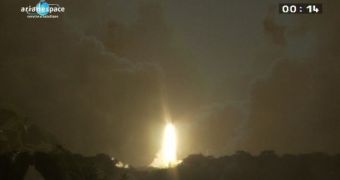JCSAT-13 and Vinasat-2 are the two latest telecommunications satellites around Earth, after being inserted into their planned transfer orbits earlier today. The spacecraft were delivered to space by an Arianespace-built Ariane 5 delivery system.
The rocket took off from the Kourou Spaceport, in French Guiana, South America, at 22:13 GMT (00:13 CEST May 16, 19:13 local time on May 15). The launch facility is operated by the European Space Agency (ESA).
This was Ariane 5's second launch for 2012, and its 62nd mission overall. The new flight, designated VA206, inserted the two satellites into a 35,911-by-249.9-kilometer (22,314-by-155-mile) orbit around the planet.
Currently experiencing a 2°-inclination, the spacecraft will soon use their onboard propulsion systems to reach their intended orbits. Their carrier rocket placed them at the designated transfer coordinates 26 and 36 minutes after takeoff, respectively.
“JCSAT-13 will be positioned above the equator at 124°E. It will deliver direct TV broadcast links to Japan and will meet satellite demands in Southeast Asia. Vinasat-2, to be positioned at 131.8°E, will provide radio, television and telephone links to Vietnam,” ESA officials say in a press release.
The satellites had a combined weight of 7,563 kilograms (16,673 pounds), while the dispensers and payload adapters weighed some 818 kilograms (1,803 pounds). Around 3 minutes and 11 seconds after the launch, the payload fairing covering the spacecraft was jettisoned.
“At 26 min 35 sec after main engine ignition, JCSAT-13 separated from the upper stage, followed by Vinasat-2 at 36 min 01 sec. Ariane 5’s flight operations were completed 48 min 30 sec after main engine ignition,” ESA reports.
Ariane 5 is arguably the most successful heavy-lift rocket ever created. Out of 62 missions, only 2 were partial failures, while all the others were completed successfully. The delivery system is built by French aerospace company Arianespace.
ESA now operates a fleet of three rockets, which it uses based on mission specifications – Ariane 5 for heavy or multiple payloads, the Russian-built Soyuz for medium-sized cargo (these rockets are launched from a dedicated pad at Kourou) and the Vega delivery system for small payloads.

 14 DAY TRIAL //
14 DAY TRIAL //